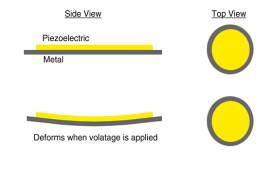Piezoelectrics
M. Herter
Piezoelectrics are a class of materials where a strain results in an electric field inside the material. In most cases, this can lead to a voltage out of the material, which can be read and interpreted by a computer or operator. The figure below is a good example. The piezo is placed on top of the metal substrate, and when a voltage is applied, the material bends, or strains. Piezos have two modes. In direct mode, a strain is applied in a voltage is obtained. In converse mode, the opposite is true. A voltage is applied and results in a small movement or deflection of the material.
Just how small are these movements? Very small is the answer. They are usually on the order of nanometers, or 10-9 meters. These are very small, but a computer easily reads the equally small voltages that result.
Piezoelectrics are a fairly new class of materials, so their potential is far from realized. Common uses for them now are in actuators, microrobotics, non-invasive medical diagnostics, and non-destructive testing. A test method that piezos are used for is Atomic Force Microscopy, or AFM. In AFM, small attractive forces between a probe and the sample are monitored at very small distances. The probe is usually connected to a piezo cantilever, and as the probe is pulled closer the surface, the piezo measures a strain and the corresponding voltage is fed into a computer. This results in a very fine map of a surface, which can be as small as atomic scale.

